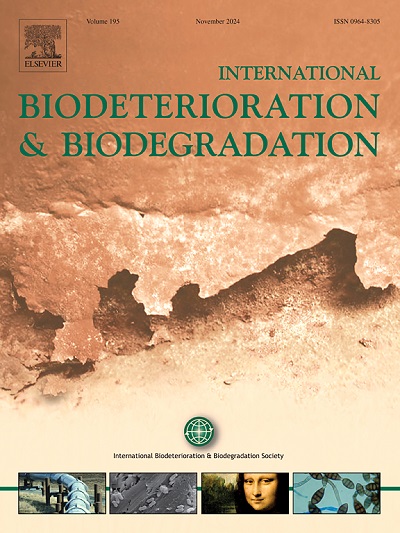Bacterial bioconsolidation of deteriorated limestone exposed to tropical conditions
IF 4.1
2区 环境科学与生态学
Q2 BIOTECHNOLOGY & APPLIED MICROBIOLOGY
International Biodeterioration & Biodegradation
Pub Date : 2025-06-11
DOI:10.1016/j.ibiod.2025.106141
引用次数: 0
Abstract
Biologically-based treatments are increasingly attracting the interest of the restoration community in Mexico. A microbially induced precipitation (MICP) strategy was implemented as a proof-of-concept based on locally isolated epilithic bacteria that were screened for biocarbonatogenic activity in vitro. Six percent (12) of the 203 tested isolates displayed urease activity and produced crystals with two different media. Isolates TM1B-407, TM1B-475, TM1B-494 and TM1B-508 were the most active isolates on both tests. The most efficient isolate was identified by 16S rRNA gene sequencing as a close relative of Rothia halotolerans strain YIM 90716. Scanning Electron Microscopy (SEM) showed that Rothia halotolerans TM1B-475 produced crystals, which by μ-X-ray fluorescence (XRF) analysis indicated a calcium carbonate composition; X-ray Photoelectron Spectroscopy (XPS) analysis confirmed that aragonite was the dominant polymorph. Efficiency of the consolidation treatments by Rothia halotolerans TM1B-475, M-3P medium (designed to stimulate the endogenous carbonatogenic community), and Ca(OH)2 was measured by cohesion (Peeling test) and surface hardness (Equotip) on damaged limestone exposed to tropical conditions and statistically analyzed after 15, 30, 45, 60, and 120 days. There was a clear trend of estimated mean detachment (95 % confidence intervals) for all treatments. On the other hand, there was not a clear trend regarding surface hardness among treatments, but a better performance of the bacterial treatment at the end of the experiment, with an increased hardness of the limestone surface was observed. This study provides the first evidence that the MICP can be used for consolidation purposes in the Yucatan Peninsula on degraded limestone under tropical conditions.
暴露在热带条件下的变质石灰石的细菌生物固结
以生物为基础的治疗方法正日益引起墨西哥修复界的兴趣。微生物诱导沉淀(MICP)策略是一种概念验证策略,该策略基于局部分离的外生石细菌,并在体外筛选其生物致碳活性。203个被测试的分离株中有6%(12个)显示脲酶活性,并在两种不同的培养基中产生晶体。分离株TM1B-407、TM1B-475、TM1B-494和TM1B-508活性最强。高效分离菌株经16S rRNA基因测序鉴定为耐盐罗氏菌YIM 90716的近亲。扫描电镜(SEM)分析表明,耐盐罗氏菌TM1B-475产生晶体,μ- x射线荧光(XRF)分析表明其成分为碳酸钙;x射线光电子能谱(XPS)分析证实文石是主要的多晶型。采用内聚力法(Peeling test)和表面硬度法(Equotip)对暴露于热带条件下的损伤石灰岩进行固结处理,并在15、30、45、60和120天后进行统计分析。所有治疗的估计平均脱离有明显的趋势(95%置信区间)。另一方面,不同处理之间的表面硬度变化趋势不明显,但细菌处理在实验结束时表现较好,石灰石表面硬度有所提高。这项研究提供了第一个证据,证明MICP可以用于尤卡坦半岛热带条件下退化石灰岩的固结目的。
本文章由计算机程序翻译,如有差异,请以英文原文为准。
求助全文
约1分钟内获得全文
求助全文
来源期刊
CiteScore
9.60
自引率
10.40%
发文量
107
审稿时长
21 days
期刊介绍:
International Biodeterioration and Biodegradation publishes original research papers and reviews on the biological causes of deterioration or degradation.

 求助内容:
求助内容: 应助结果提醒方式:
应助结果提醒方式:


